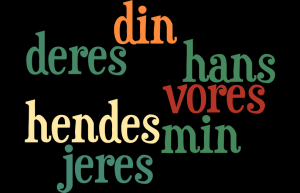 You’ll probably not find this in your grammar book, but the most important thing to ask yourself when you want to use a possessive pronoun (”my”, ”her”…) in Danish is this: Does it end in an -s? If yes, you’re lucky: hans, hendes, vores, jeres, deres NEVER change:
You’ll probably not find this in your grammar book, but the most important thing to ask yourself when you want to use a possessive pronoun (”my”, ”her”…) in Danish is this: Does it end in an -s? If yes, you’re lucky: hans, hendes, vores, jeres, deres NEVER change:
Hans cykel, hendes bil, vores hus, jeres garage, deres børn – Cyklen er hans, bilen er hendes, huset er vores, garagen er jeres, børnene er deres (His bike, her car, our house, your garage, their children – The bike is his, the car is hers, the house is ours, the garage is yours, the children are theirs).
Min (mine) and din (yours), however, are just as wishy-washy as your typical adjective. Let’s repeat:
• -t is a neuter ending
• -e is a plural ending
So, you say:
Har du set min paraply/mit rejsekort/mine briller? (Have you seen my umbrella/my travel card/my glasses?)
Nej, jeg har ikke set din paraply/dit rejsekort/dine briller…
Stop, wait, it can’t be this easy!
Okay, it’s true, there IS the small word sin [seen]… It does not exist in English, but can be translated as ”his (own)” or ”her (own)”. It’s inflected just like ”mine”: sin, sit, sine. I’d better demonstrate:
Hun drak sin latte. (She drank her [own] latte.)
Han tog sin hat og gik. (He took his [own] hat and left.)
In both those phrases, sin refers back to the person drinking or taking. Not a big deal, maybe, but if you go ahead like you would in English, the meaning actually changes:
Hun drak hendes latte. (She drank her [someone else’s] latte.)
Han tog hans hat og gik. (He took his [someone else’s] hat and left.)
Got it? 🙂 If in doubt, you can always replace pronouns with names:
Anna Larsen snakker med Anna Larsens veninde > Hun snakker med sin veninde (She’s talking with her friend).
Anna Larsen snakker med Helle Jensens veninde > Hun snakker med hendes veninde
If you feel like a total mess now, don’t worry: Danes are having a lot of sin trouble themselves! In fact, in dialects such as the traditional Århus dialect, sin isn’t really used… Just pretend you’re a dialect speaker and do your best to follow the conversation! 🙂





